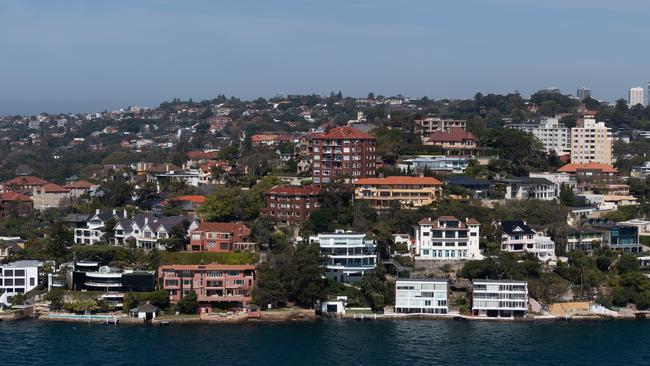ANZ’s wealthy postcode loan policy makes housing market inequality worse at the wrong time
The chasm between those seeking a way into the nation’s housing market and those that can take advantage of borrowing more to scoop up higher-end properties is getting markedly wider.

The chasm between those seeking a way into the nation’s housing market and those who can take advantage of borrowing more and scooping up higher-end properties looks to be getting markedly wider.
ANZ’s decision this month to move ahead with a new policy that classifies 145 postcodes – deemed wealthier and lower risk – as being able to borrow up to 95 per cent of a property’s value without lenders’ mortgage insurance, exemplifies a shift in the market.
Lenders’ mortgage insurance acts to protect the bank or lender against the borrower being unable to pay their loan. It is, however, the borrower that pays the LMI insurance premium.
ANZ started a trial earlier in the year that assessed the risk and reward around this policy, giving it the green light from early June. It’s the first time a big bank has introduced such a sweeping measure that allows a borrower to sidestep the cost of lenders’ mortgage insurance, and it is being closely watched by rivals and regulators alike.
Given the vastly inequitable nature of the housing market, perhaps ANZ should have considered introducing or trialling a similar measure for first home buyers on a limited scale that is not driven by postcode.
Banks have at various times provided LMI waivers for first home buyers, but few if any, of these exist in the market at the moment.
As governments look to address the underlying issue of housing supply – which is the biggest problem the nation is grappling with – banks should contribute to the broader debate about access to the housing market through product design and policy.
The federal government’s first home guarantee was a small step in the right direction. In 2023-24, through the provision of 35,000 places, it provided new housing market entrants access to participating lenders with as little as 5 per cent deposit and without paying lenders’ mortgage insurance. Funnily enough, ANZ is the only major bank that is absent among the big four from a panel of some 32 participating lenders.
ANZ’s new policy spans borrowers in 145 specified postcodes – including Northbridge, Bronte, Manly, Cremorne and Killara in Sydney; Brighton and Lorne in Melbourne; Hamilton in Brisbane and Cottesloe in Perth – who can apply for loans of up to $4.75m under the policy, as long as they have a strong repayment history and are deemed low-risk. That includes earning an annual income exceeding about $400,000 and not being too heavily in debt on a debt-to-income ratio measure.
The minimum loan amount is $2m and borrowers in ANZ’s trial were thought to have received mortgages priced in line with the broader market, although in some instances up to 35 basis points was added to the prevailing rate due to customisation.
The new policy excludes any postcodes in South Australia, Tasmania and Northern Territory.
ANZ has obviously conducted deep analysis around this policy change but real thought needs to be given to addressing how younger cohorts even fathom getting into the housing market. The bank of mum and dad is an increasingly popular option, but again, that may only be the case in those higher socio-economic postcodes ANZ is gravitating to.
Martin Currie Australia portfolio manager Matthew Davison told this column: “I’d imagine they (ANZ) have some data set that’s showing the implied credit risk is less than the ultimate cost for the LMI premium, so they are happy to take on the extra capital and find the new business.”
Either way, the prudential regulator will keep close watch on ANZ’s policy and how it is being implemented from a risk management and capital perspective. The Australian Prudential Regulation Authority does not prescribe the level of capital the major banks have to hold against home loans with lower levels of deposits, but it does expect they will take lenders’ mortgage insurance into account when they are making the assessment.
That’s because the big banks don’t have to hold as much capital against a home loan if it is tied to lenders’ mortgage insurance. Typically, LMI at the vast majority of large lenders kicks in when a borrower’s deposit or equity is less than 20 per cent of the property value.
The higher the level of a borrower’s deposit the lower the LMI premium paid will be.
Interestingly, ANZ’s websites flags that LMI waivers are available for those working in the legal, medical or accounting professions. Levels across these professions vary.
Whichever way you look at it, LMI is a highly-prohibitive cost even for those in the higher socio-economic income groups and postcodes, and in some respects it is surprising this part of the market hasn’t already been disrupted. The payment does, though, need to offset the additional risk to the lender for the bigger exposure to the bank.
RateCity’s analysis shows for a $2m loan, taken out for 30 years, the LMI cost to an owner-occupied borrower is a mammoth $102,849, which balloons to $391,960 for a loan of $7.6m.
Jumping the gun
Westpac chief Peter King is getting ahead of himself.
In making comments about Westpac considering joining Commonwealth Bank in scrapping bonus caps for home loan bankers, he seems to have lost sight of the fact his bank is yet to be given a clean bill of health by APRA.
On May 6, Westpac told investors it had completed an integrated plan to improve its risk culture, governance and accountability, but no word yet about whether APRA is satisfied the changes are embedded and sustainable.
Remember Westpac paid a record $1.3bn fine to financial crimes regulator Austrac in 2020 relating to millions of breaches of anti-money laundering laws.
That was followed by Westpac launching legal action against Forum Finance and its boss Bill Papas the following year, alleging he was able to defraud the bank of hundreds of millions of dollars.
Westpac has yet to prove to APRA its risk management and compliance systems are robust enough for the regulator to remove the $1bn in additional capital the bank is holding because of its many governance failings.
On the other hand, NAB had its $500m capital overlay - which was imposed in 2019 - removed in March when APRA said it was satisfied the bank had completed its remediation program and addressed risk and governance issues.
CBA, which had its regulatory failings exposed earlier, was hit with an additional capital charge of $1bn by APRA in May 2018. That was cut by half by APRA in late 2020 when the regulator deemed the bank to be making good progress on rectifying compliance issues. CBA’s remaining capital overlay was removed in September 2022.
And ANZ continues to have a $500m capital overlay from APRA due to governance failings.
So what to make of King’s comments on home loan banker bonus caps? “After recent changes in the industry, we’re considering our approach to ensure we remain competitive and keep the best bankers,” he said.
A bit premature.
Originally published as ANZ’s wealthy postcode loan policy makes housing market inequality worse at the wrong time




